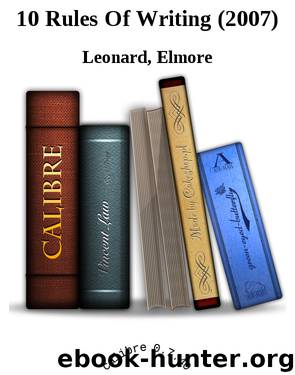10 Rules Of Writing (2007) by Leonard Elmore

Author:Leonard, Elmore [Elmore, Leonard,]
Language: eng
Format: epub, mobi
Published: 2011-01-21T02:29:34.890000+00:00
USE REGIONAL DIALECT, PATOIS, SPARINGLY
Once you start spelling words in dialogue phonetically and loading the page with apostrophes, you won't be able to stop. Notice the way Annie Proulx captures the flavor of Wyoming voices in her book of short stories Close Range.
*
*
AVOID DETAILED DESCRIPTIONS OF CHARACTERS
Which Steinbeck covered. In Ernest Hemingway's Hills Like White Elephants, what do the American and the girl with him look like? She had taken off her hat and put it on the table. That's the only reference to a physical description in the story, and yet we see the couple and know them by their tones of voice, with not one adverb in sight.
*
*
DO NOT GO INTO GREAT DETAIL DESCRIBING PLACES AND THINGS
Unless you're Margaret Atwood and can paint scenes with language or write landscapes in the style of Jim Harrison. But even if you're good at it, you don't want descriptions that bring the action, the flow of the story, to a standstill.
And finally:
*
*
TRY TO LEAVE OUT THE PART THAT READERS TEND TO SKIP
A rule that came to mind in 1983, at lunch with Book-of-the-Month Club editors. Think of what you skip reading a novel: thick paragraphs of prose you can see have too many words in them.
What the writer is doing, he's writing, perpetrating hooptedoodle, perhaps taking another shot at the weather, or has gone into the character's head, and the reader either knows what the guy's thinking or doesn't care. I'll bet you don't skip dialogue.
*
*
My most important rule is one that sums up the ten.
If it sounds like writing, I rewrite it.
Or, if proper usage gets in the way, it may have to go.
I can't allow what we learned in English composition to disrupt the sound and rhythm of the narrative.
It's my attempt to remain invisible, not distract the reader from the story with obvious writing.
(Joseph Conrad said something about words getting in the way of what you want to say.) If I write in scenes and always from the point of view of a particular character the one whose view best brings the scene to life I'm able to concentrate on the voices of the characters telling you who they are and how they feel about what they see and what's going on, and I'm nowhere in sight.
What Steinbeck did in Sweet Thursday was title his chapters as an indication, though obscure, of what they cover. Whom the Gods Love They Drive Nuts is one, Lousy Wednesday another. The third chapter is titled Hooptedoodle 1 and the thirty-eighth chapter Hooptedoodle 2 as warnings to the reader, as if Steinbeck is saying: Here's where you'll see me taking flights of fancy with my writing, and it won't get in the way of the story. Skip them if you want.
Sweet Thursday came out in 1954, when I was just beginning to be published, and I've never forgotten that prologue.
Did I read the hooptedoodle chapters?
Every word.
Download
This site does not store any files on its server. We only index and link to content provided by other sites. Please contact the content providers to delete copyright contents if any and email us, we'll remove relevant links or contents immediately.
Asking the Right Questions: A Guide to Critical Thinking by M. Neil Browne & Stuart M. Keeley(5649)
Autoboyography by Christina Lauren(5184)
Eat That Frog! by Brian Tracy(4436)
Dialogue by Robert McKee(4323)
Sticky Fingers by Joe Hagan(4103)
Journeys Out of the Body by Robert Monroe(3572)
Annapurna by Maurice Herzog(3424)
Full Circle by Michael Palin(3389)
Schaum's Quick Guide to Writing Great Short Stories by Margaret Lucke(3321)
Elements of Style 2017 by Richard De A'Morelli(3307)
The Art of Dramatic Writing: Its Basis in the Creative Interpretation of Human Motives by Egri Lajos(3017)
Atlas Obscura by Joshua Foer(2900)
The Diviners by Libba Bray(2887)
Why I Write by George Orwell(2877)
In Patagonia by Bruce Chatwin(2876)
The Fight by Norman Mailer(2848)
The Mental Game of Writing: How to Overcome Obstacles, Stay Creative and Productive, and Free Your Mind for Success by James Scott Bell(2845)
Venice by Jan Morris(2526)
The Elements of Style by William Strunk and E. B. White(2442)
